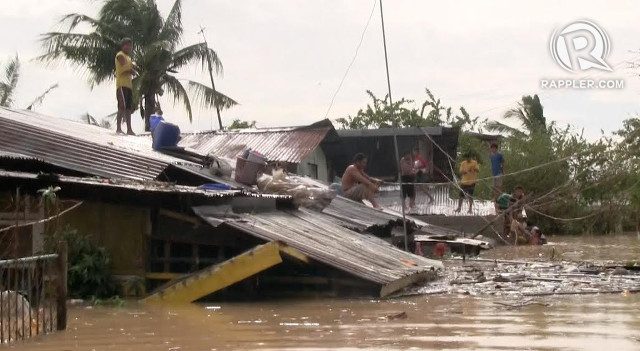SUMMARY
This is AI generated summarization, which may have errors. For context, always refer to the full article.

CABANATUAN CITY, Philippines – The morning of Monday, October 19, saw Cabanatuan City slowly rising from the depths of muddy flood waters brought by Typhoon Lando (international name Koppu).
“First time ever sa kasaysayan ng Nueva Ecija. Akala ko nga 4 years ago yung Pedring na yung pinaka mataas pero hindi pala, ito talaga,” said Joanne Guevarra, a resident of barangay Aduas Norte
(This is the first time ever in the history of Nueva Ecija. I thought 4 years ago Pedring had the highest floods but no, it’s this storm.)
This sentiment was among the first to be voiced out by rescued residents as they boarded the truck.
“We never experienced these kinds of floods before,” said 59-year-old Anna Mateo of Aduas Centro village in Filipino.
Though rescue operations began the previous night amid heavy downpour, rescue teams were still rushing the next morning to heed requests for help in villages that remained submerged.
Those still under head-high floods as of Tuesday morning include the barangays Aduas Norte, Aduas Centro, Aduas Sur, Sumakab, and Isla.
Separated, reunited
Thirteen-year-old Raprap Guevarra spent the entire night on top of a metal roof on the second floor of his friend’s house in Aduas Norte.
His mother, Joanne, was up all night as well, desperately contacting rescue teams from the Padre Gregorio Crisostomo Elementary School evacuation center. She had been separated from Raprap and had no means to fetch him herself.
“Talagang naghi-hysterical na nga ako kasi nga syempre ang bilis ng taas ng tubig, baka abutin na yung tinutungtungan nila, wala nang kakapitan,” she told Rappler.
(I was hysterical because the water was rising fast, it could reach where they were standing, they would have nothing to hold on to.)
She almost lost hope when by 11 pm, she noticed there were fewer rescue personnel. She had been told that a team was sent to the area where her son was stranded but they were not able to cut through because of the strong floods.
“They were able to send a team but they couldn’t access the area because of the water’s strong current. They had to stop where it was passable,” she said in Filipino.

But at 8:30 am the next day, she was able to hug Raprap as he climbed onto a Red Cross rescue truck.
Around 20 others were rescued by the Red Cross Bravo team that morning from Aduas Norte. Before them, the team had fetched 64 residents from floods higher than the height of two men in Sumakab village.
The rescued included a pregnant woman, an elderly woman, a new-born baby, and several infants.
Unexpected flood heights
Residents said they were not prepared for the speed at which flood waters rose.
Areas which before could expect floods to subside after reaching the knee were inundated by waters that went beyond their heads.
This lack of preparation was one reason why many got stranded in their homes.
“Hindi nga siya nakabalik dahil napakabilis ng pagtaas ng tubig. Within 30 minutes, hanggang dibdib,” said Guevarra, referring to Raprap who had promised to follow her to the evacuation center.
(He was not able to go back because because the water rose so fast. Within 30 minutes, it reached the chest.)
Kids use styrofoam pieces as makeshift floating devices in Aduas Norte, Cabanatuan City #LandoPH @rapplerdotcom pic.twitter.com/POe9rX8tK8
— Pia Ranada (@piaranada) October 19, 2015
That morning, children could be seen wearing pieces of styrofoam as makeshift floating devices, as they made their way towards the trucks.
They were given bread to eat as the Red Cross team dropped by other parts of the villages. The rescue volunteers had been at work since around 6 am.
While they were lucky to have a motorized boat, other rescue teams made do with bangkas.
“The boats have to be motorized because of the strong water flow,” said Aduas Norte barangay volunteer Rod Mondejal in Filipino.
He said the most urgent needs right now are for these boats, and food for the volunteers.
But without such equipment, his group is prepared to just tie rope from one end of the street to another to help responders guide their crafts through the rushing waters.
Nueva Ecija is among the 10 provinces that remained under public storm signal number 1 as of Monday noon.
Lando continues moving at a speed of 5 km/h, and is moving towards the north-northeast, PAGASA said in its 10 am bulletin. The speed of the typhoon is being affected by another storm to the east, Typhoon Champi, and the presence of a high pressure area, the weather bureau added. – Rappler.com
Add a comment
How does this make you feel?
There are no comments yet. Add your comment to start the conversation.